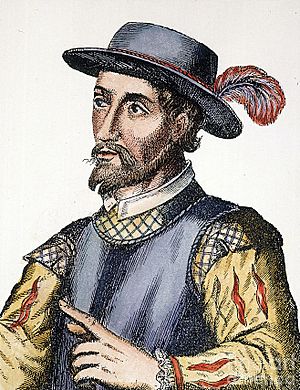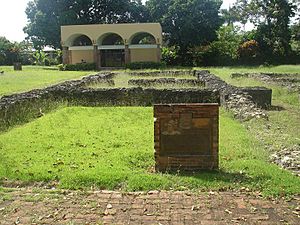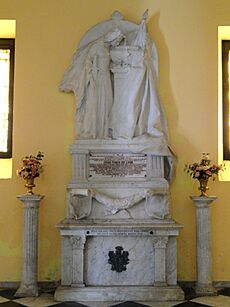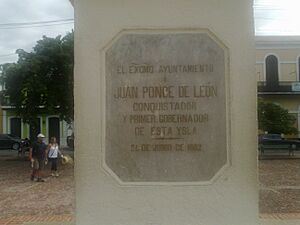Juan Ponce de León facts for kids
Quick facts for kids
Juan Ponce de León
|
|
|---|---|

An unauthenticated 17th-century engraving of Ponce de León
|
|
| 1st, 3rd, and 7th Governor of Puerto Rico | |
| In office 1508–1509 |
|
| Preceded by | Office established |
| Succeeded by | Juan Cerón |
| In office 1510–1511 |
|
| Preceded by | Juan Cerón |
| Succeeded by | Juan Cerón |
| In office 1515–1519 |
|
| Preceded by | Cristóbal de Mendoza |
| Succeeded by | Sánchez Velázquez/Antonio de la Gama |
| Personal details | |
| Born | c. 1474 Santervás de Campos, Castile |
| Died | July 1521 (aged 46–47) Havana, Governorate of Cuba |
| Resting place | Cathedral of San Juan Bautista (San Juan, Puerto Rico) |
| Spouses | 2 |
| Relations |
|
| Children | 3 |
| Profession | Explorer |
| Signature |  |
Juan Ponce de León (born around 1474 – died July 1521) was a Spanish explorer and a conquistador. He is famous for leading the first official European trip to Puerto Rico in 1508. He also led the first known European expedition to Florida in 1513.
Ponce de León was born in Santervás de Campos, Spain. He came from a noble family and joined the Spanish military when he was young. In 1493, he traveled to the Americas with Christopher Columbus on his second voyage.
By the early 1500s, Ponce de León was a top military leader in Hispaniola. He helped put down a rebellion by the native Taíno people. In 1508, he was allowed to explore the nearby island of Puerto Rico. He became the first Governor of Puerto Rico in 1509.
Ponce de León became very rich from his farms and mines. However, he had a legal fight with Diego Colón, Christopher Columbus's son. Colón claimed the right to govern Puerto Rico. After a long court battle, Colón replaced Ponce de León as governor in 1511. King Ferdinand then encouraged Ponce de León to explore other parts of the Caribbean Sea.
In 1513, Ponce de León led the first European expedition to a place he named La Florida. He landed on Florida's east coast. His ships then mapped the Atlantic coast down to the Florida Keys. They also explored north along the Gulf coast. Many people believe he was looking for the Fountain of Youth, but historians say this is a myth.
Ponce de León went back to Spain in 1514. King Ferdinand made him a knight and governor of Puerto Rico again. He also gave him permission to settle Florida. He returned to the Caribbean in 1515. However, his plans to go to Florida were delayed when King Ferdinand died in 1516. Ponce de León had to go back to Spain to protect his titles. He did not return to Puerto Rico for two years.
In March 1521, Ponce de León finally went to Southwest Florida. He led the first big attempt to start a Spanish colony there. But the native Calusa people fought back fiercely. Ponce de León was badly hurt in a fight. The attempt to colonize failed, and he died from his wounds soon after in Cuba. His body was later buried in the Cathedral of San Juan Bautista in San Juan.
Contents
Early Life in Spain
Juan Ponce de León was born in the village of Santervás de Campos. This area is in the northern part of Valladolid, Spain. While some older records say he was born in 1460, newer evidence suggests he was born in 1474.
His family name, Ponce de León, dates back to the 13th century. It came from a noble family. Juan Ponce de León was related to important figures like Rodrigo Ponce de León, Duke of Cádiz. This duke was a famous hero in the wars against the Moors.
As a young man, Ponce de León served as a page and then a squire. He likely fought in the Granada War. This war ended in 1492 when the Catholic Monarchs conquered the last Muslim kingdom in Spain. This military experience prepared him for his future explorations.
Journey to the New World
In September 1493, about 1,200 people joined Christopher Columbus for his second voyage. Ponce de León, who was 19, joined this expedition. He was one of 200 "gentleman volunteers."
The fleet reached the Caribbean in November 1493. They visited several islands, including a large one the natives called Borikén. This island later became known as Puerto Rico. This was Ponce de León's first look at the place that would be very important to him.
Historians are not sure what he did for the next few years. It is possible he went back to Spain. He might have returned to Hispaniola with Nicolás de Ovando later.
Life in Hispaniola
In 1502, Nicolás de Ovando became the new governor of Hispaniola. He was sent to bring order to the colony. Ovando believed he could take control of the native Taínos. He allowed a terrible event called the Jaragua massacre in 1503.
In 1504, Taínos attacked a Spanish fort in Higüey. Ovando sent Ponce de León to stop the rebellion. Ponce de León helped crush the uprising. As a reward, Ovando made him governor of the new province of Higüey.
Ponce de León did very well in this role. He received a large piece of land. He also gained the right to use native labor for his farm. He sold his crops and animals to Spanish ships. In 1505, Ovando allowed him to build a new town called Salvaleón.
In 1508, King Ferdinand gave Ponce de León permission to conquer the remaining Taínos. He also allowed him to force them to mine for gold. Around this time, Ponce de León married Leonora. They had three daughters and one son. His large stone house, called Salvaleón, still stands today.
Governing Puerto Rico

As governor, Ponce de León heard stories from captured Island Caribs. They spoke of gold on the nearby island of San Juan, now Puerto Rico. They described a rich land with much gold in its rivers. Ponce de León asked for and received permission to explore the island.
The official Spanish settlement of San Juan is often dated to 1508. Ponce de León landed with about 50 men on the southern coast. However, records show he led an earlier expedition in 1506. This earlier trip was to explore, settle, and conquer the island.
His earlier exploration confirmed the presence of gold. It also gave him a good understanding of the island's geography. In 1508, King Ferdinand gave him permission for the first official expedition. Ponce de León led a small group to Puerto Rico. They found gold in the western part of the island.
This expedition left Hispaniola on July 12, 1508. They anchored in San Juan Bay, near today's city of San Juan. Ponce de León found a good spot inland. He built a storehouse and a fortified house there. This became the first settlement in Puerto Rico, called Caparra.
The settlers spent most of their time looking for gold. By early 1509, Ponce de León returned to Hispaniola. His expedition had found a lot of gold. The expedition was a great success. Ovando made Ponce de León governor of San Juan Bautista. King Ferdinand confirmed this on August 14, 1509. He was told to expand the settlement and keep mining for gold.
The new governor returned to the island with his family. Many Spaniards from Hispaniola came to mine gold. This disrupted the lives of the native Taíno people. Ponce de León used a system called encomienda. This forced the Taínos to work for him and other settlers.
The Taínos were made to grow food and mine for gold. Many Spaniards treated the Taínos very harshly. Death rates were very high. The demand for slaves from other islands grew. In June 1511, the Taínos rebelled. Ponce de León and his small army quickly put down the rebellion.
While Ponce de León was settling the island, political changes were happening. On July 10, 1509, Diego Colón, Christopher Columbus's son, arrived in Hispaniola. He became the acting Viceroy, replacing Nicolás de Ovando. Colón had been fighting in court for his right to inherit his father's titles.
The Spanish Crown wanted more direct control in the New World. Despite their wishes, Colón won in court. King Ferdinand had to appoint him Viceroy. The courts had said Ponce de León should stay in office. But Colón appointed his own officials, taking away Ponce de León's power.
This continued until March 2, 1510. Then, Ferdinand ordered that Ponce de León's position as governor be restored. Ponce de León had Colón's officials arrested and sent back to Spain. The political struggle between Colón and Ponce de León went on for years. Ponce de León had strong supporters in Spain. But Colón's position as Viceroy made him a powerful enemy.
Eventually, it became clear that Ponce de León could not stay in San Juan. On November 28, 1511, Colón's officials returned from Spain. They were officially reinstated as governor.
First Voyage to Florida in 1513
By 1511, rumors of new islands northwest of Hispaniola reached Spain. King Ferdinand wanted to stop Colón from exploring these lands. To reward Ponce de León, Ferdinand told him to find these new lands. These lands would be outside Colón's control. Ponce de León quickly agreed to this new adventure. In February 1512, a royal contract was sent. It outlined his rights to search for "the Islands of Beniny."
The contract said Ponce de León had exclusive rights to find Beniny and nearby islands for three years. He would be governor for life of any lands he discovered. But he had to pay for all exploration and settlement himself. The contract also gave rules for sharing gold and other profits with the king. It did not mention a rejuvenating fountain.
Ponce de León prepared three ships with at least 200 men. He paid for everything himself. They left Puerto Rico on March 4, 1513. The only detailed account of this trip comes from Antonio de Herrera y Tordesillas. He was a Spanish historian who wrote about it in 1601.
The three ships were the Santiago, the San Cristobal, and the Santa Maria de la Consolacion. Anton de Alaminos was their main pilot. He was very experienced. After leaving Puerto Rico, they sailed northwest. They went along the chain of Bahama Islands, then called the Lucayos.
Herrera wrote that on March 27, 1513, Easter Sunday, they saw land. It was an island unfamiliar to the sailors. Some historians believe this "island" was actually Florida. It was thought to be an island for years after its discovery.
For the next few days, the fleet crossed open water. On April 2, they saw land again. Ponce de León thought it was another island. He named it La Florida. He chose this name because of the green landscape. It was also the Easter season, which Spaniards called Pascua Florida (Festival of Flowers). The next day, they landed to claim this new land.
The exact landing spot in Florida has been debated. Some historians think it was near St. Augustine. Others suggest a more southern landing near Ponce de León Inlet. The expedition sailed north for the rest of that day. They anchored for the night and went ashore the next morning.
After about five days, the ships turned south to explore more of the coast. On April 8, they met a very strong current. It pushed them backward and forced them to anchor. The smallest ship, the San Cristobal, was lost for two days. This was the first time Europeans encountered the Gulf Stream. This current would later become the main route for ships going from the Spanish West Indies to Europe.
They continued down the coast, staying close to shore. By May 4, the fleet reached and named Biscayne Bay. They got water at an island they called Santa Marta (now Key Biscayne). They also explored a native town at the mouth of the Miami River. The native people did not interact with the Spanish.
On May 15, they left Biscayne Bay. They sailed along the Florida Keys. They were looking for a way to go north and explore Florida's west coast. From a distance, the Keys looked like suffering men to Ponce de León. So, he named them Los Martires (the Martyrs).
They found a gap in the reefs. They sailed "to the north and other times to the northeast." On May 23, they reached the Florida mainland. Here, they met the Calusa people. The Calusa refused to trade. They drove off the Spanish ships with warriors in canoes.
The exact landing spot here is also debated. Many believe it was near Charlotte Harbor. Others suggest Tampa Bay or even Pensacola. Ponce de León anchored for several days to get water and repair ships. The Calusa at first seemed interested in trading, but soon became hostile.
Several small fights happened, with injuries on both sides. The Spanish captured eight Calusa people. They also took five war canoes. On June 5, a final fight happened. About 80 Calusa warriors attacked eleven Spanish sailors. It was a standoff, with neither side getting close enough to attack.
On June 14, they sailed again. They were looking for islands to the west that their captives had described. They reached the Dry Tortugas on June 21. There, they caught giant sea turtles, Caribbean monk seals, and many seabirds. From these islands, they sailed southwest. They tried to go around Cuba and return to Puerto Rico.
They did not account for the strong currents pushing them east. They hit the northeast shore of Cuba. At first, they were confused about their location. Once they knew where they were, the fleet went back east. They went along the Florida Keys and around the Florida peninsula. They reached Grand Bahama on July 8.
They were surprised to find another Spanish ship there. It was piloted by Diego Miruelo. He was either on a slaving trip or spying on Ponce de León. Soon after, Miruelo's ship was wrecked in a storm. Ponce de León rescued the stranded crew.
From here, the fleet split up. Ponce de León sent the Santa Maria to explore more. He returned home with the rest of the crew. Ponce de León reached Puerto Rico on October 19, 1513. He had been away for almost eight months. The other ship returned safely on February 20, 1514.
Ponce de León is often given credit for discovering Florida. However, he was probably not the first European to reach the peninsula. Spanish slave expeditions had been raiding the Bahamas since 1494. There is some evidence that some of these slavers reached Florida's shores. The Cantino Map from 1502 also shows a peninsula near Cuba that looks like Florida.
The Fountain of Youth Myth
According to a popular legend, Ponce de León found Florida while searching for the Fountain of Youth. Stories of waters that restore youth were known before Ponce de León. But the story of him looking for them was not linked to him until after his death.
In his 1535 book, Historia general y natural de las Indias, Gonzalo Fernández de Oviedo y Valdés wrote that Ponce de León was looking for the waters of Bimini. A similar story appears in Francisco López de Gómara's 1551 book, Historia general de las Indias.
Then in 1575, Hernando de Escalante Fontaneda published his memoir. He was a shipwreck survivor who lived with Florida's Native Americans for 17 years. He wrote that the waters called the River Jordan were in Florida. He also said Ponce de León was supposed to have looked for them there.
Fontaneda doubted that Ponce de León really went to Florida looking for the waters. But the story was included in Antonio de Herrera y Tordesillas's 1615 book. Most historians believe that finding gold and expanding the Spanish Empire were much more important goals for Ponce de León.
Between Voyages to Florida
When Ponce de León returned to Puerto Rico, the island was in chaos. A group of Caribs attacked the settlement of Caparra. They killed several Spaniards and burned the town. Ponce de León's own house was destroyed. His family barely escaped.
Colón used this attack as an excuse to fight the local Taíno tribes again. Ponce de León suspected that Colón was trying to weaken his position. He also thought Colón might try to take his claims to the newly discovered Florida.
Ponce de León decided to return to Spain. He wanted to report his expedition's results in person. He left Puerto Rico in April 1514. King Ferdinand welcomed him warmly in Valladolid. There, he was knighted and given his own coat of arms. He was the first conquistador to receive these honors.
He also visited the Casa de Contratación in Seville. This was the main office for all of Spain's activities in the New World. The Casa took detailed notes of his discoveries. They added them to the Padrón Real, a master map. This map was used for official navigation charts for Spanish captains.
During his stay in Spain, a new contract was made for Ponce de León. It confirmed his rights to settle and govern Beniny and Florida. Florida was then thought to be an island. The contract also said that the Requerimiento had to be read to the native people. This was a document that told them to accept Spanish rule. Ponce de León was also ordered to form a fleet. This fleet would attack the Caribs, who kept attacking Spanish settlements.

Three ships were bought for his fleet. After repairs, Ponce de León left Spain on May 14, 1515. The details of his fights against the Caribs are unclear. There was one battle in Guadeloupe when he returned to the area. There might have been two or three other encounters.
The campaign ended suddenly in 1516 when King Ferdinand died. The king had been a strong supporter. Ponce de León felt he had to return to Spain. He needed to protect his rights and titles. He received support from Cardinal Francisco Jiménez de Cisneros, who governed Castile. But it was almost two years before he could return to Puerto Rico.
Meanwhile, at least two unauthorized trips to "his" Florida had happened. Both ended with the native Calusa or Tequesta warriors fighting them off. Ponce de León realized he had to act soon to keep his claim.
Last Voyage to Florida
In early 1521, Ponce de León put together a colonizing expedition. It included about 200 men, including priests, farmers, and artisans. They brought 50 horses, other animals, and farming tools on two ships. The expedition landed somewhere on the coast of southwest Florida. It was likely near Charlotte Harbor or the Caloosahatchee River. These were areas Ponce de León had visited before.
Before the settlement could be built, the colonists were attacked by the Calusa. These were the native people who controlled southern Florida. Their main town was nearby. Ponce de León was badly wounded in the fight. Historians believe an arrow, poisoned with sap from the manchineel tree, hit his thigh.
The expedition immediately gave up the attempt to colonize. They sailed to Havana, Cuba. Ponce de León soon died there from his wounds. He was buried in Puerto Rico. His remains were moved in 1836 to the Cathedral of San Juan Bautista. His tomb has these words in Latin: "Under this structure rest the bones of a lion, more for his great deeds than for his name."
Legacy and Honors
- The World War II Liberty Ship SS Ponce De Leon was named in his honor.
Images for kids
See also
 In Spanish: Juan Ponce de León para niños
In Spanish: Juan Ponce de León para niños
- Agüeybaná I
- Agüeybaná II
- Becerrillo, a dog owned by Juan Ponce de León
- History of the Americas
- Hayuya
- Jumacao






